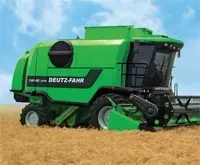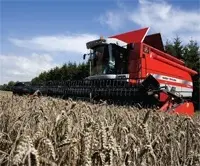The success of the harvest is a major factor in the financial results of many farms, and in some cases combinable crops provide the farm’s entire annual income, which is why the skill of the combine operator has such an important part to play.
The latest combine harvesters offer the power and capacity to produce much more output than older machines, but many of them are also equipped with features that help the driver to maintain peak output and to adapt more quickly to changing crop conditions.
Although the efficiency aids that are increasingly available from many of the leading manufacturers can make it easier for drivers, including those with limited experience, they should are not a substitute for having a properly trained operator in the cab. The contribution they make is to provide automatic control of some of the routine and repetitive driving functions, giving the operator more time to concentrate on other aspects of managing the harvester. They also help to take some of the stress out of the driver’s job to help maintain peak working efficiency for longer periods. Among the earliest examples of equipment designed to help the operator are the various control systems that automatically maintain the correct cutting height and, on some combines, also adjust the angle of the cutting head to match changes in the ground contours.
All of the major manufacturers offer this type of control system which play an important part in maintaining output and efficiency when working on an undulating ground surface. Failing to adjust the cutting height to variations in the field surface can lead to costly repairs if the cutter bar contacts the soil. Another established example of equipment that can improveharvesting efficiency is an automatic guidance system that takes over the steering while the combine cuts the crop. Claas introduced their Laser Pilot guidance equipment 10 years ago and it is now available throughout their Lexion combine range and on Tucano models.
The Laser Pilot identifies the edge of the standing crop and uses this data to control the steering automatically and position the header so that it cuts the maximum width of crop. It can also operate in the dark, allowing the combine to continue working through the night if necessary.
Laser Pilot is more accurate and responds more rapidly than even a skilled operator, and maintaining the maximum cutting width not only boost the combine’s output but it also reduces the amount of fuel used to harvest the crop. The control system works automatically while the driver is not touching the steering wheel, but manual control is restored instantly if the driver turns the wheel to steer around an obstruction or to make a headland turn and the driver also controls the steering while the harvester is travelling to or from the field.
Automatic steering
Other leading harvester manufacturers have developed their own automatic steering technology, and an example is the SmartSteer system from New Holland which uses infra-red sensing to identify the uncut edge of the crop. Case IH chose the name Cruise Cut for their laser controlled guidance system which is available on some of their Axial Flow rotary combine models. An alternative automatic guidance method is to use a system based on signals from the GPS network of space satellites. Claas offers a complete range of GPS equipment including their Baseline HD system that is said to offer steering accuracy within 6cm, and as well as keeping the cutterbar filled it can also select the most efficient cutting pattern for each field to minimise time-wasting short work.
John Deere’s AutoTrac hands-free steering system is also satellite based, which is said to give greater precision and better reliability than relying on laser guidance. It is based on Greenstar, John Deere’s comprehensive information and control system that also includes HarvestSmart, a control mechanism that constantly adjusts the forward speed to maintain the optimum setting selected by the operator.
HarvestSmart, available on the ‘i’ or ‘intelligent’ versions of some of the top models in the John Deere range, allows the operator to choose one of two setting options. In the ‘Capacity’ mode the control system automatically selects the forward speed that will maintain maximum output, but with the ‘Smart’ setting the speed and feed rate are limited by the level of grain loss the operator chooses. The work rate is reduced if a very low figure is selected for grain loss, but accepting a higher loss limit will allow HarvestSmart to maintain a bigger output.
Cruise Pilot is the automatic speed and throughput control system developed by Claas and introduced on their range-topping Lexion 600 combine. It constantly processes data collected from sensors on the front elevator and the engine to maintain the work rate selected by the operator, making adjustments automatically to compensate for changes in crop density or variations in gradient.
One of the features on the new 591hp CR9090 combine announced last year by New Holland and claimed to be the world’s highest output harvester is Graincam, a high tech system that photographs the harvested grain and uses a computer to analyse the images while the combine is working.
The image analysis is programmed to measure the amount of broken grains in the sample plus the level of impurities such as straw fragments and weed seeds. Data from the Graincam analysis is displayed on a screen inside the cab, enabling the operator to adjust the combine settings if the quantities of impurities and damaged grains are excessive. Straw walkers A special feature of the Centora combine range announced by Massey Ferguson last year ready for the 2009 harvest is the cleaning system with eight straw walkers. This provides one-third more separation area than a combine with six straw walkers, the makers say, and is said to be available only on the two Centora models. It is claimed to produce an exceptionally clean grain sample and in conjunction with the Centora’s high output threshing system it is said to achieve faster work rates with reduced fuel consumption.
 Also introduced last year as part of Massey Ferguson’s bid for a bigger share of world combine sales is the Fortia range of rotary combines. Three models are available with engine outputs from 378 to 459hp, and the top model in the range is said to offer the biggest work capacity ever achieved by a Massey Ferguson combine. Grain tank capacity on the biggest of the Fortia rotary combines is a massive 12,300 litres, making it one of the biggest available on any harvester, and it is also claimed to have the fastest unloading speed with a delivery rate of 158 l/sec. A big grain tank capacity is yet another aid to harvesting efficiency because it reduces the risk of hold-ups while waiting for the next empty grain trailer and it also gives the operator more flexibility to choose a suitable unloading opportunity.
Also introduced last year as part of Massey Ferguson’s bid for a bigger share of world combine sales is the Fortia range of rotary combines. Three models are available with engine outputs from 378 to 459hp, and the top model in the range is said to offer the biggest work capacity ever achieved by a Massey Ferguson combine. Grain tank capacity on the biggest of the Fortia rotary combines is a massive 12,300 litres, making it one of the biggest available on any harvester, and it is also claimed to have the fastest unloading speed with a delivery rate of 158 l/sec. A big grain tank capacity is yet another aid to harvesting efficiency because it reduces the risk of hold-ups while waiting for the next empty grain trailer and it also gives the operator more flexibility to choose a suitable unloading opportunity.
The rotary threshing concept was originally introduced by International Harvester – now Case IH – on the first Axial Flow models. Since then the company has remained at the forefront of rotary combine development and their most recent introduction is a new threshing rotor with a reduced internal diameter. Called the ST or Small Tube rotor it is said to offer more space between the rotor and the concaves to boost output by allowing an increased flow of crop material but with a lower level of straw damage – a major factor in areas where straw has a value and is baled.
While most of the emphasis in combine harvester development is on high capacity models aimed at the top end of the market, Same Deutz- Fahr has recently announced three new mid-range models. They all have five straw walkers and a 7500 litres grain tank, cutting widths are from 4.2m upwards and the power units are 250 to 310hp. The list of design improvements includes a new digital display to provide the driver with more comprehensive information about the operation of the combine including data on the engine load and a display showing the cutting height.
Small to medium capacity combines are the speciality of the Sampo Rosenlew range, which includes some machines with a no-frills specification. Their range includes the four-model SR2000 series of harvesters with a four or five-straw walker cleaning system and a standard specification that includes a 93hp engine on the smallest models, increasing to 110hp for the SR2065 at the top of the range. More powerful engines are on the options list. Sampo Rosenlew also offers the SR1010 mini-sized combine used mainly for harvesting trials plots, a job in which achieving maximum output is a long way down the priorities list.








